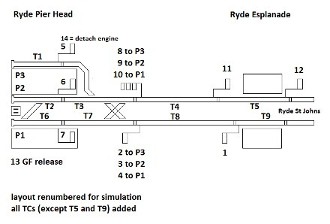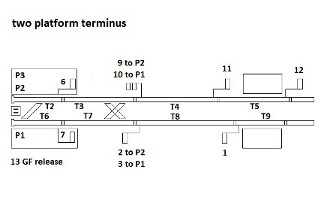Ryde Pier Head (3 platforms) simulation
As explained elsewhere, one module on its own will simulate a terminus. Thus it makes an interesting challenge to find an interesting location which will fit on just one chip. Ryde Pier Head appears to be one such location.
A little liberty was taken with the layout shown shown here, in that I added most of the track circuits (or else you've no idea where the trains are!). Special code was written for the TC chip, to allow the running of engines around (or between) trains. To do this, switch 13 acts as ground frame release (although there's no readback to show if the GF is normal or not: the switch is operated as soon as a train occupies - for example - T2 and replaced as soon as an engine appears on T6). The three platform layout with run rounds shown here is the very limit of what can be fitted on the TC chip. In reality, Ryde Pier Head had 3 platforms until the 4th was added in the 1930's. Shortly after developing this simulation, I obtained an Isle of Wight Working Timetable (shown elsewhere on this web site) from 1936, when RPH had 4 platforms. On a busy summer Saturday in the middle of the day, there were 6 departures and 6 arrivals per hour. This section of the timetable was duly programmed onto the timetable chip. My WTT doesn't give platform information, but it turns it can be operated with just 3 platforms - provided one follows the rule that Ventnor stopping trains use platform 1, Cowes trains platform 2 and other Ventnor trains platform 3. This makes an entertaining little simulation - but one with no room for error! A few simplifications were necessary to make the layout fit on the chip. For example, a train cannot be longer than T3 or T7 (i.e. you can't have three TC lamps illuminated at once). General 2 platform terminus: As part of developing Ryde Pier Head, I also generated this slightly simpler terminus. In this case, trains can be longer than T3 or T7. Notes added 21/5/2016: I don't know the actual bell codes used at Ryde Pier Head, but this simulation is programmed with 4 = Ventnor non stopping; 3-1 = Ventnor stopping; 1-3 = Cowes. The simulator features the following bell signals: Is Line Clear, Train Entering Section, Train out of section (without call attention, in this case). (It also allows train approaching, banking engines, permissive working, and blocking back (2-4, 3-3 or 3-3-4), but these do not feature in the Ryde Pier Head simulation. Opening and closing of signal box, wrong direction working, and the emergency signals, are not catered for). This simulation uses 16 signal inputs; these are 'diode multiplexed', i.e. it requires a box with 16 switches, with diodes soldered to them (circuit diagram is given in the manual - see further information page).

